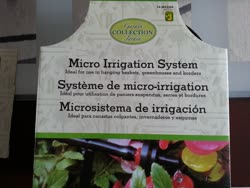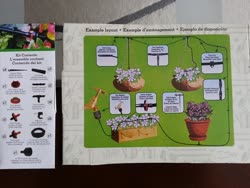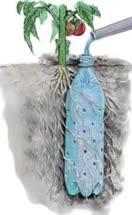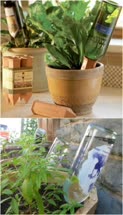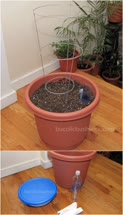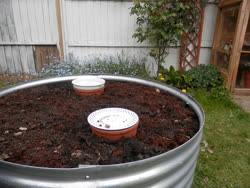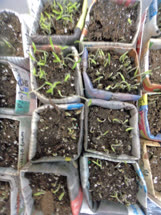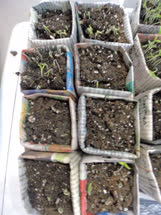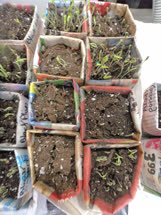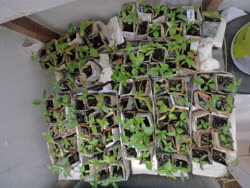About Gravity Feed
In gravity feed systems water will always take the path of least resistance. This should be considered if you decide to place tubing on the ground and punch holes every few inches. What you will run into is that the openings closest to the water source will discharge much more water than the openings farther away on the line. If the distance is longer, you may not even get any water flow out of the last holes on the line. Distance could be as long as 50 feet or as little as 10 feet. This will depend on the height of the bucket/container, the pressure available, and the flow uniformity of the system. Efficiency, and uniformity of gravity feed systems can be improved by selecting a low flow dripper, such, as .5 GPH (2 L/H), and raising the pressure in the system (by raising the height of the bucket from the ground). With drippers, you have better control of flow rate in comparison to poking a hole in the tubing, and also better uniformity from the system due to the dripper water passage.With a gravity feed system you need to fill the container daily or every other day. Also, the only way to adjust the time for the tank to empty, or the drippers' flow rate, is to change the height of the tank, the volume of the tank, and/or the number of drippers in the system. Another problem with gravity feed systems is that the size of the system is limited by the size of the bucket/ container; in general, a container large enough to provide adequate flow and pressure to increasingly larger areas would quickly become unmanageable. Also, as we add more outlets (drippers) to the line, uniformity will decrease, with more water at the beginning of the line and less at the end. In addition, as the water level in the bucket drops, the drippers' flow rate drops.
To have an effective gravity feed system; consider the size of the bucket/ tank and the number of drippers. Our suggestion is to make sure that the flow rate per outlet is at least .034 GPH (1.28 l/h).
Like drip irrigation, gravity feed systems need a minimum pressure to operate. To gain pressure in gravity feed systems, use this calculation:
To gain water pressure by using gravity means you must raise the water source (bucket/container) above the system lines. For every 1' (12 cm) of elevation above the system you will gain .433 PSI (.030 bar). This means that if your water source is 10 feet (3m) above the system you will have 4.33 PSI (.30 bar) at the start of the system. (.433 x 10 = 4.33)
Keep in mind that with low pressure, such as 4.33 PSI (.30 bar), you will have the following;
Limited distance to run the 1/2" or 1/4" line.
The flow rate of the .5 GPH drip emitters recommended is considerably below the manufacturer's suggested flow rate.
A drastic drop in uniformity once you exceed certain line length.
The chart below is for a gravity feed system using a 1/4" drip line with drippers every 12" (30 cm). In this design we use a 10 gallon (38L) bucket with 9 gallons (30L) of water at a pressure range less then 1 PSI on flat terrain
Container Size Height above the drip system Length of drip line run Dripper Flow rate Container close to empty in:
10 gallon 8" 10' .034 GPH 1.28 l/h 35 minutes
10 gallon 12" 10' .036 GPH 1.36 l/h 30 minutes
10 gallon 12" 14' .041 GPH 1.55 l/h 25 minutes
10 gallon 16" 14' .042 GPH 1.58 l/h 20 minutes
Installing gravity feed drip system using a 10-gallon bucket
Parts suggested for a gravity feed system for 5 lines of 10' (3m) length, each using a 1/4"drip line with drippers pre inserted every 12" (30 cm):
Minimum 10 gallon bucket for a system of 12' x 10' (3.6 x 3 meter) with bucket height a minimum of 8" (20 cm) above the ground Estimated cost for the bucket $3 to $10. This system can cover up to 5 rows of 10' (3 m) long, each using our drip irrigation components for a 12' (3.6 m) x 10' (3 m) garden using a 10 gallon (37.85 L) container at a height of 8" to 16" (20 to 40 cm) above the ground.
Installation
Drill a 3/4" hole in the bucket about 1" from the bottom.
From inside the bucket insert a 3/4" x 1" nipple with o-ring model SWF013, listed for $.62 each.
From the outside of the bucket, thread a model A029 3/4" adaptor, listed for $.75 each, to the nipple.
To the adaptor connect a 3/4" filter model F303, listed for $8.95 each.
To the filter connect a ball valve model A123, listed for $2.45 each.
To the ball valve connect a 4" to 10" section of 1/2" tubing.
To the tubing connect a 1/2" elbow model LF007, listed for $.65 each.
To the elbow add another section of 1/2" tubing model T004 from the height of the bucket to the ground.
To the end of the 1/2" drip tubing section add an additional elbow model LF007, listed for $.65 each.
From the elbow lay out the drip tubing to the garden model T004, listed for $6.25 pr 50' and connect to the elbow.
Near each row of plants punch a hole in the 1/2" hose and insert a 1/4" barb model SF001, listed for $.12 each.
To the barb connect 10' to 14' of 1/4" drip line model T022, listed for $19.99 for 100' with drippers every 12".
To punch the hole in the 1/2"tubing use punch model A019, listed for $1.45.
Fill the bucket with water and turn the ball valve on to flush the line, and as the water is running, close the end of the 1/2" tubing using hose end model A006, listed for $.12 each, and close the 1/4" drip line using the small side of the goof plug, model SF007, listed for $.51 for 10 plugs.
Total cost for the system will be around $53.00, depending on bucket cost.
dripirrigation
